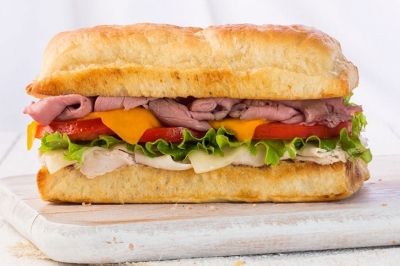
Filled with just jam or layered with spicy meat, cheese and vegetables, sandwiches are one of the most popular quick-meal options today.
What exactly is a sandwich?
A sandwich is any food that consists of two slices of bread with a filling in between. This dish is generally eaten as a light meal. However, the definition changes from one place to another. For instance, burritos and hot dogs are also considered sandwiches in New York, but Massachusetts, a nearby State in the U.S., does not accept burritos as sandwiches.
Origin
The first sandwich was made in England in the mid-1700s for John Montagu, the 4th Earl of Sandwich. Most food historians believe that Montagu, who was addicted to gambling, spent several hours at the card table and did not even take breaks for meals. During one of his long games, he reportedly asked his cook to prepare something he could eat without getting up from his seat. The cook is said to have prepared a dish with meat stuffed between two slices of bread, and the sandwich was born. Some food historians believe that the cook might have drawn inspiration from the West Asian Mezze platter (a snack tray with a selection of appetizers). Documents such as diary entries from this period suggest that the noble men of the kingdom began consuming sandwiches after it was popularized by Montagu. Other gamblers and busy people eating sandwiches, and by the end of 1760s, it became common. It was noted that by 1789, King George III and his family always took a supply of sandwiches on outings. Though America is currently one of the highest consumers of sandwiches, the dish was not popular in the region until the 1820s. Some believe the Americans intentionally avoided culinary trends from their former colonizer. However, as time passed by, sandwiches were adapted to suit local preferences and were included in American cookbooks and restaurant menus.
One of the most iconic events in the history of sandwiches is the invention of the bread-slicing machine by American inventor Otto Rohwedder in the 1920s. This machine made it possible to get uniform, thin and neat slices of bread that can be packed and sold. By the end of the 20th Century, sandwiches became a global hit, with each region having its own variant.
Across the world
As mentioned above, most countries have their own iconic sandwiches. Here are a few famous ones:
Vietnamese Banh Mi
This consists of a baguette (French bread) split lengthwise and filled with various savoury ingredients and flavoured with cilantro, jalapenos and mayonnaise.
Bombay sandwich
This sandwich consists of cucumber, carrot, lettuce, mayonnaise, processed cheese, boiled potato and a generous layer of cilantro chutney.
Portuguese Francesinha
This rich sandwich is made of ham, sausage and steak layered between sliced bread. The sandwich is topped with melted cheese and a tangy red sauce.
The largest sandwich
The largest sandwich was prepared by Wild Woody’s Chill and Grill, Roseville, Michigan, the U.S. on March 17, 2005. The sandwich weighed about 2,467.5 kg and measured 17.5 inches in thickness and was 12 ft long and 12 ft wide. It contained 68 kg mustard, 468 kg corned beef, 118 kg cheese, 240 kg lettuce and 1,618 kg bread.
In the mood for something quirky?
If you’re bored eating the regular sandwiches, there are a wide range of offbeat options such as, banana and bacon’; banana and mayonnaise; instant noodles; harm, cheese and Oreos; chicken and Nutella; and cheese and maple syrup.
Picture Credit : Google

